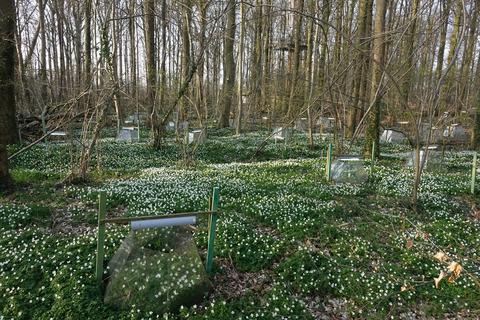Our official English website, www.x-mol.net, welcomes your feedback! (Note: you will need to create a separate account there.)
Rapid thermophilization of understorey plant communities in a 9 year-long temperate forest experiment
Journal of Ecology ( IF 5.5 ) Pub Date : 2021-03-23 , DOI: 10.1111/1365-2745.13653 Sanne Govaert 1 , Pieter Vangansbeke 1 , Haben Blondeel 1 , Kathy Steppe 2 , Kris Verheyen 1 , Pieter De Frenne 1
中文翻译:

在为期 9 年的温带森林试验中对林下植物群落进行快速嗜热
更新日期:2021-03-23
Journal of Ecology ( IF 5.5 ) Pub Date : 2021-03-23 , DOI: 10.1111/1365-2745.13653 Sanne Govaert 1 , Pieter Vangansbeke 1 , Haben Blondeel 1 , Kathy Steppe 2 , Kris Verheyen 1 , Pieter De Frenne 1
Affiliation

|
- The vast majority of plant biodiversity associated with temperate forests is harboured by the understorey layer. This layer also plays crucial roles in ecosystem functions such as tree regeneration, nutrient cycling and carbon dynamics. Research using space-for-time substitutions and resurveys of vegetation plots has shown that climate warming, changes in forest management and resource availability are key determinants of forest understorey biodiversity change and functioning. However, long-term experiments are needed to better unravel their complex interactive effects.
- Here we study the influence of nearly a decade of experimental warming, light addition using fluorescent tubes (as a proxy for management-driven changes in forest-floor light levels) and nitrogen input on understorey plant communities of temperate broadleaved forest.
- Plant communities shifted towards a higher dominance of warm-adapted species, a process referred to as thermophilization. We detected a marked community shift in all treatments including the control plots, reflecting ongoing ambient environmental changes. This reordering over time was greater than the shift induced by the treatments. Thermophilization was, however, greatest when temperature and/or light availability were enhanced. Communities were also taller in response to warming and increased light availability.
- Synthesis. Our experiment provides important insights into 9 years of vegetation changes in a temperate forest and how canopy density and forest management can be adapted to limit thermophilization of forest understorey biodiversity under climate change. [Correction added on 27 April 2021, after first online publication: The Synthesis section in the abstract has been updated to reflect the original text supplied.]
中文翻译:

在为期 9 年的温带森林试验中对林下植物群落进行快速嗜热
- 与温带森林相关的绝大多数植物生物多样性都位于下层。该层还在生态系统功能中发挥着至关重要的作用,例如树木再生、养分循环和碳动态。使用时空替代和植被图重新调查的研究表明,气候变暖、森林管理和资源可用性的变化是森林下层生物多样性变化和功能的关键决定因素。然而,需要长期的实验来更好地解开它们复杂的交互作用。
- 在这里,我们研究了近十年的实验性变暖、使用荧光管的光添加(作为管理驱动的森林地板光照水平变化的代理)和氮输入对温带阔叶林下层植物群落的影响。
- 植物群落转向温暖适应物种的更高优势,这一过程被称为嗜热。我们在包括对照地块在内的所有处理中检测到显着的社区变化,反映了持续的周围环境变化。随着时间的推移,这种重新排序大于治疗引起的转变。然而,当温度和/或光可用性提高时,嗜热作用最大。社区也因气候变暖和光照增加而变得更高。
- 合成。我们的实验提供了对温带森林 9 年植被变化的重要见解,以及如何调整冠层密度和森林管理以限制气候变化下森林下层生物多样性的高温化。[更正于 2021 年 4 月 27 日添加,首次在线发表后:摘要中的综合部分已更新,以反映所提供的原始文本。]


























 京公网安备 11010802027423号
京公网安备 11010802027423号